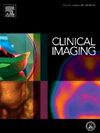影响同侧和对侧乳房乳腺 X 光检查乳腺癌监测效果的因素
IF 1.8
4区 医学
Q3 RADIOLOGY, NUCLEAR MEDICINE & MEDICAL IMAGING
引用次数: 0
摘要
目的乳腺X光检查是乳腺癌(BC)治疗后影像监测的主要手段,但也可能出现假阴性。本研究旨在确定哪些因素可分别预测同侧和对侧乳房的第二次乳腺癌(SBC)乳房X光检查检出率较低的情况。研究方法对曾接受过乳腺癌治疗,并在第一次乳腺癌治疗后10年内在同侧(ISBC)或对侧乳房(CSBC)发生第二次乳腺癌(SBC)的女性患者进行了多中心回顾性研究。2006年1月至2017年10月期间发生的SBC病例被纳入机构数据库。ISBC和CSBC的乳腺X光检查发现率(MO)与乳腺X光检查乳腺密度以及首次BC的各种临床、放射学和组织学特征相关。39.4%的病例(108/274)为 ISBC,60.6%的病例(166/274)为 CSBC。35例(32.4%)的ISBC和42例(25.3%)的CSBC为MO(P = 0.218)。在多变量分析中,无症状的首次 BC(p = 0.041)、诊断 SBC 时乳腺组织普遍致密(p = 0.003)和监测乳房 X 光片上的小梁增厚(p = 0.017)与 MO ISBC 相关。结论该研究发现了与同侧和对侧乳房乳腺 X 线造影监测失败相关的各种临床、放射学和病理学因素。这些信息可为规划使用辅助影像筛查的个性化监测计划提供更多指导。本文章由计算机程序翻译,如有差异,请以英文原文为准。
Factors affecting mammogram breast cancer surveillance effectiveness in the ipsilateral and contralateral breast
Aim
Mammography is the mainstay of imaging surveillance after breast cancer (BC) treatment, but false negatives can occur. The objective of the study was to determine the factors that can predict poorer second breast cancer (SBC) mammogram detection of the ipsilateral and contralateral breast separately.
Methods
A multicentre retrospective review was performed on female patients with a previous history of treated BC who developed a second breast cancer (SBC) in the ipsilateral (ISBC) or contralateral breast (CSBC) within 10 years from the first BC. SBC cases that occurred between January 2006 and October 2017 were included from the institutional database. The ISBC and CSBC mammogram-occult (MO) rates were correlated with mammographic breast density as well as various clinical, radiological and histological characteristics of the first BC.
Results
274 cases of SBC were evaluated. 39.4 % (108/274) of cases were ISBC and 60.6 % (166/274) were CSBC. 35 (32.4 %) of the ISBCs and 42 (25.3 %) of the CSBCs were MO (p = 0.218). On multivariate analysis, symptomatic first BC (p = 0.041), prevailing dense breast tissue at the time of SBC diagnosis (p = 0.003) and trabecular thickening on surveillance mammograms (p = 0.017) were associated with MO ISBC. MO first BC (p < 0.001) was the only factor found to correlate with MO CSBC.
Conclusion
The study found various clinical, radiological and pathological factors associated with mammogram surveillance failure for the ipsilateral and contralateral breast. This information can provide additional guidance in the planning of a personalised surveillance program using adjunct imaging screening.
求助全文
通过发布文献求助,成功后即可免费获取论文全文。
去求助
来源期刊

Clinical Imaging
医学-核医学
CiteScore
4.60
自引率
0.00%
发文量
265
审稿时长
35 days
期刊介绍:
The mission of Clinical Imaging is to publish, in a timely manner, the very best radiology research from the United States and around the world with special attention to the impact of medical imaging on patient care. The journal''s publications cover all imaging modalities, radiology issues related to patients, policy and practice improvements, and clinically-oriented imaging physics and informatics. The journal is a valuable resource for practicing radiologists, radiologists-in-training and other clinicians with an interest in imaging. Papers are carefully peer-reviewed and selected by our experienced subject editors who are leading experts spanning the range of imaging sub-specialties, which include:
-Body Imaging-
Breast Imaging-
Cardiothoracic Imaging-
Imaging Physics and Informatics-
Molecular Imaging and Nuclear Medicine-
Musculoskeletal and Emergency Imaging-
Neuroradiology-
Practice, Policy & Education-
Pediatric Imaging-
Vascular and Interventional Radiology
 求助内容:
求助内容: 应助结果提醒方式:
应助结果提醒方式:


